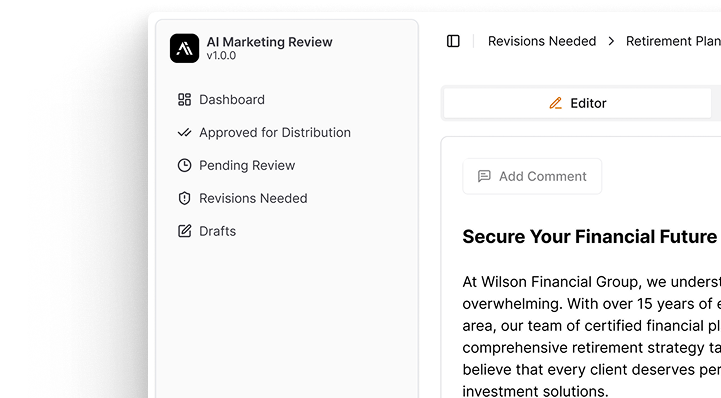The SEC’s Marketing Rule, formally known as Rule 206(4)-1 under the Advisers Act, sets the standards for how investment advisers may advertise their services. The rule aims to protect investors from misleading marketing practices while giving firms a clear framework for promoting their expertise and results.
Why Firms Need to Comply
Non-compliance with the Marketing Rule can lead to SEC enforcement actions, significant fines, reputational damage, and loss of client trust. The rule applies broadly — covering websites, social media, presentations, email campaigns, and other promotional communications — making it essential for firms to have a documented review and approval process for all marketing materials.
Key Requirements Under the Marketing Rule
While the rule contains many details, several core requirements apply to most firms:
- Performance Presentation: Present performance data fairly, with all required time periods included, and without overemphasizing short-term results.
- Testimonials and Endorsements: Disclose any compensation or material conflicts of interest.
- Third-Party Ratings: Ensure ratings are relevant, credible, and supported by clear disclosures.
- Hypothetical Performance: Limit use to appropriate audiences, supported by policies, procedures, and risk disclosures.
- Policies and Procedures: Maintain written compliance procedures that govern marketing content creation, review, and approval.
Common Risks of Non-Compliance
- Incomplete Disclosures: Missing required explanations or disclaimers.
- Inconsistent Formatting: Using different standards across materials for the same type of content.
- Cherry-Picked Data: Highlighting only top-performing segments or periods without context.
- Unarchived Materials: Lacking accessible records for SEC examinations.
How Firms Can Comply
To meet the Marketing Rule’s requirements, firms should build a compliance process that ensures all marketing content is reviewed and approved before publication. This process should include:
- Internal Education: Train marketing and compliance teams on the rule’s requirements.
- Standardized Templates: Use approved layouts with required disclosures and balanced presentations built in.
- Centralized Review Process: Maintain a consistent, documented approval workflow for all materials.
- Archiving and Version Control: Store all versions, edits, and approvals in a secure, searchable archive.
Tools to Support Compliance
Technology can make compliance faster and more consistent. Archive Intel’s AI Marketing Review tool automates content review, verifies required time periods, suggests compliant language, and can make approved edits directly in the document — all with a timestamp for audit readiness. Every version is archived, creating a defensible record for SEC exams.
Bottom Line
SEC Marketing Rule 206(4)-1 raises the bar for transparency and accuracy in adviser marketing. Firms that invest in clear processes, comprehensive training, and the right compliance tools can meet the rule’s requirements, reduce risk, and maintain client trust — while keeping marketing operations efficient.
Ready to stay compliant with AI Marketing Review? Schedule a demo.
